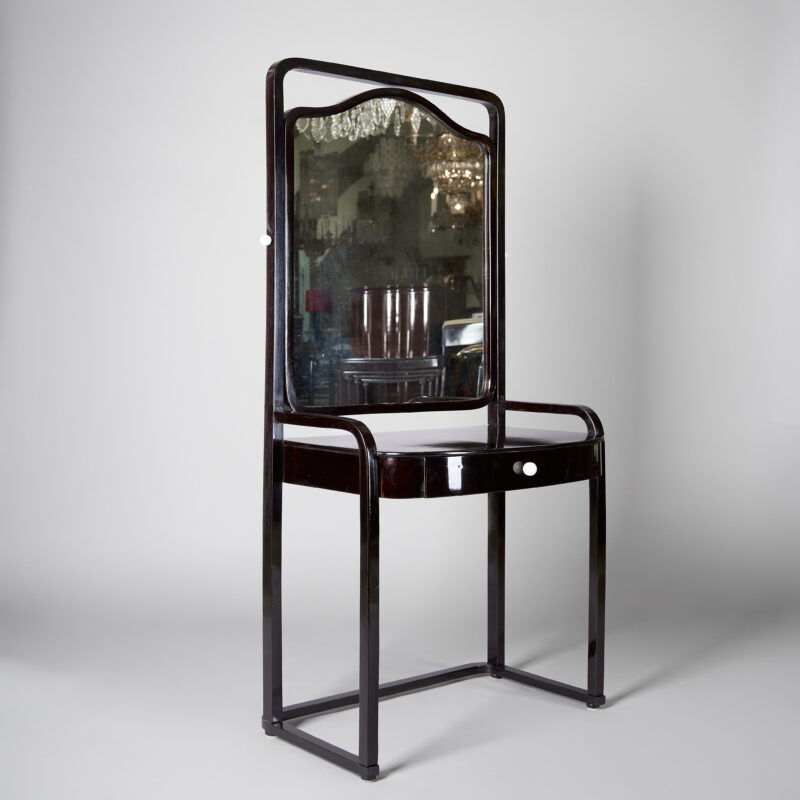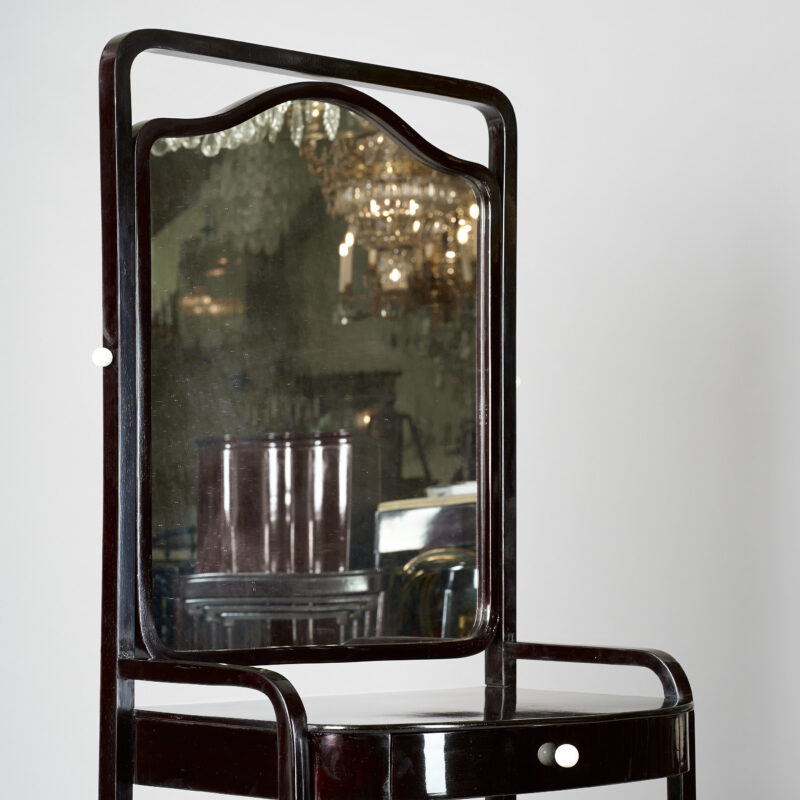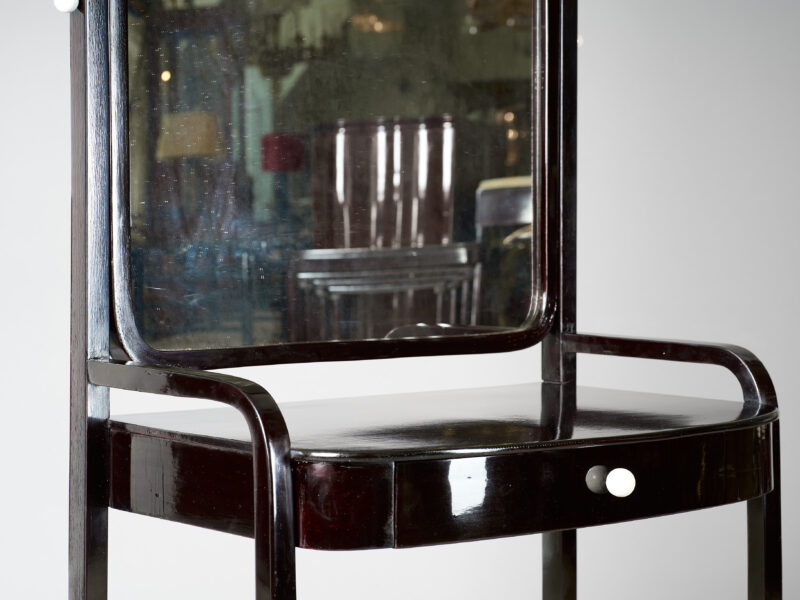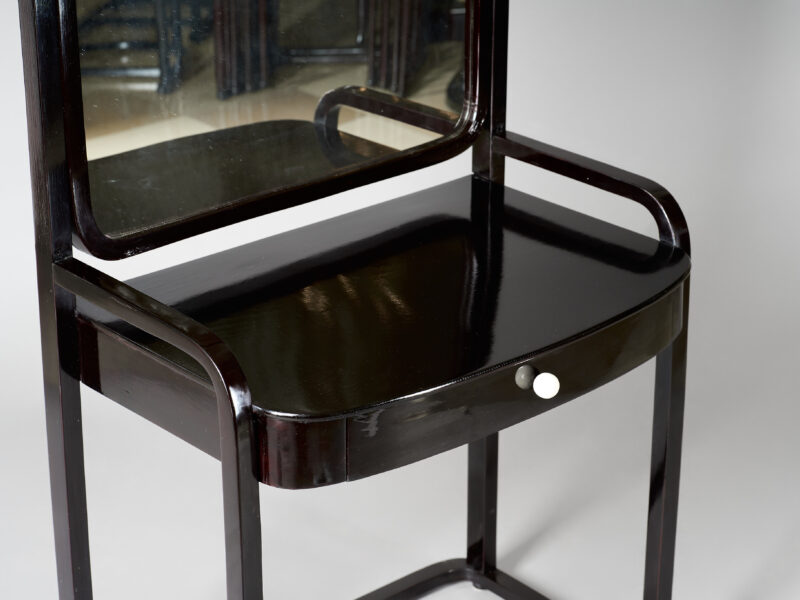
Josef Hoffmann, Dressing Table
Formally one of the most beautiful designs of a dressing table or vanity of this period, designed by one of the most significant architects and designers as well as the founder of the Wiener Werkstätten, Josef Hoffmann.
Executed by Jacob and Josef Kohn from beech, beechwood, and plywood stained in dark mahogany and polished with shellac. Pull knob of the large center drawer and the mirror fixings in spherical form worked in white. The frame is square, which sets this dressing table apart from models made of round bentwood.
Labels signed on the underside of the drawer.
Stylistically, this design is attributed to the furnishings designed by J. Hoffmann for the Fledermaus Cabaret.
Literature: Kohn Catalog 1906; “Renzi, il mobile moderneo”, p. 192. Model number: 1135
Josef Hoffmann (1870−1956):
Josef Hoffmann was born in 1870 in Pirnitz/Moravia during a socially and economically challenging time, but it was also the beginning of the Industrial Revolution with all its positive and negative aspects. Hoffmann began his architectural studies in 1892 at the Academy of Fine Arts in Vienna under Carl von Hasenauer and Otto Wagner. He became fascinated early on with the English-Scottish Arts & Crafts movement. Their vision was to infuse all aspects of life with art, to design everyday objects more beautifully and aesthetically, and thus to make artistically designed objects accessible to a wider societal stratum. Hoffmann, as well as his teacher Otto Wagner, believed that art could even have a healing effect on the human soul. They envisioned a much larger role for the architect; from now on, the architect should simultaneously be a designer and redesign all objects to be used. Hoffmann remained true to this creed throughout his life.
At the young age of just 29, Hoffmann was already appointed as a professor at the University of Applied Arts in Vienna. One of the significant steps in Hoffmann’s career came in 1897 when he, along with Gustav Klimt, Koloman Moser, Joseph Maria Olbrich, Carl Moll, and others, joined the Vienna Secession, which saw itself as a counter-movement to the established artists. Only six years later, together with Koloman Moser and with the support of the industrialist Fritz Waerndorfer, Hoffmann founded the Wiener Werkstätte in 1903.
Among Hoffmann’s first iconic masterpieces, one must count the Sanatorium Purkersdorf, implemented in 1904, where Hoffmann had designed everything down to the smallest detail, from the interior design to the gardens. This total work of art set almost radical new standards in the view of architecture and design. One of Josef Hoffmann’s most significant works, with which he ultimately achieved international breakthrough, was the Palais Stoclet in Brussels. With this building, which he realized between 1905 and 1911, he was able to fully realize his vision of the total work of art. Architecture and design merge with daily life, and art becomes an aesthetic part of our everyday lives.
An interesting aspect of the idea of the total work of art is that the significant Danish-Austrian master builder and architect of classicism and historicism, Theophil Edvard Hansen (1813 in Copenhagen — 1891 in Vienna), already had the vision of a total work of art of building and interior design and was able to implement this idea in some of his projects in Vienna. The strict and clear design language of Hoffmann’s designs paved the way for modernism and, like the designs of Adolf Loos, are works of timeless elegance, crafted to the highest quality and execution. A significant quote might be that of Le Corbusier, in which he said about Josef Hoffmann: “… today, as the new generations … appropriate the fruits of the work of the true pioneers … it is only fair … to express our gratitude to men like Professor Hoffmann and to enterprises that were as bold as the Wiener Werkstätte. Finally, what remains is the indispensable superfluous — art.”


